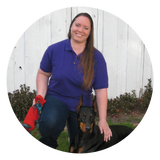Remember: Odor Moves

This sounds obvious. Yet, how many times do people work a search and prevent their dog from following where the odor cone is traveling? Are you guilty of this? If so, what can you do instead?
ODOR DOESN'T LISTEN TO SEARCH AREA BOUNDARIES
Here's a scenario for you: You're trialing with your dog and need one more Q to finally get that title you've been clamoring for. One last search. You get to the start line, take a look around, looking for the boundaries of your search area. Coming up with a plan-of-attack, you take a deep breath and cue your dog to begin to search. Almost immediately, they shoot off to leave the boundary. You put on the breaks and tell them to get back to work! Yet your dog tries to do this over and over again and you can feel that Q quickly fading away. Why are they being so difficult?! Just go search!
Well, as it turns out your dog was searching. They were chasing the odor cone to try to figure out where the odor was coming FROM. You were essentially preventing them from working the problem.
Now, I'm not trying to make you feel bad if you've done this before. It is completely understandable from a human perspective.
"DON'T PASS THOSE BOUNDARY FLAGS"!
However, odor doesn't listen to these arbitrary search area boundaries. It is not as though there is an invisible force field surrounding your search area, keeping the odor within it!
If you have a significant amount of wind or airflow, in addition to how the area is designed with hills, dips and valleys, the odor can flow a fair distance away not only from the hide but from the search area itself!
There was one particular Scent Work trial I was officiating for that stands out in illustrating how limiting your dog's ability to chase the odor cone can cause a problem. It was an Exterior search where there was raised hill on the left side of the search area and concrete and flat grassy area on the right. The hide was placed in the middle of the search area under a metal decorative structure, still accessible to the dogs. However, the wind was going from left to right. That meant it came down the hill, hit the hide, skid across the concrete and collected on the grassy area, just beyond the search area boundaries. Dog after dog tried to chase that odor cone, and handler after handler stopped them. The few who actually did allow their dogs to chase the odor cone not only Q'd, but received a super fast total search time.
The point being, odor will move and interact with the whole of the space, not just what is within the search area boundaries. If your dog is actively hunting and asks to leave the search area boundaries for a few feet, let them! This doesn't mean going the next town over, but allowing your dog to move out 6'-10' outside those boundary flags is not going to kill you.
ODOR FLOWS IN CONTAINER SEARCHES TOO
It always surprises me when people are shocked how much odor can flow within a Container search.
"Well, the odor is CONTAINED! The dog should just sniff that particular container and be done!"
Not true.
The reason your dog can detect the odor at all is that it is ESCAPING the container. If it is was truly contained, there would be no odor for your dog to detect.
So, every little bit of odor that does escape can then actively interact with the environment around it. Every time you and your dog go down that line of containers, you are dragging a little bit of odor with you. Opening and closing of doors? That is sucking and blowing air around the space, and moving the odor as a result.
"Great, what do I do now?!"
I'm not suggesting blowing up how you tackle a Container search. Rather, keep in mind that odor movement is indeed a possibility. If your dog is continuing down a line where a straight row of containers were, it doesn't mean your dog is suddenly no longer working or is getting distracted. They may very well be chasing odor!
Look at how the space is set-up. Are the containers near anything? What is the flooring like? Are there doors opening and closing? Is HVAC on or off? All of this matters!
So instead of yanking your dog back onto the containers and getting frustrated, perhaps give them the space to determine how they need to work out the odor puzzle.
VEHICLES AND ODOR FLOW
As an instructor and trial official, one of the search elements that causes the most angst is Vehicles. Not due to anything with the vehicles themselves, rather how handlers tend to work them with their dogs.
Essentially, a vehicle is hollow. Odor will flow all throughout the frame and OFF of the vehicle. The longer the hide is on the vehicle, the longer the odor has to flow all around it and off of it.
Park a vehicle next to a puddle of standing water or vegetation like grass or bushes, where do you think that odor is going to go? Off the vehicle and toward those elements.
Yet time and time again you will see handlers holding their dogs right up next to the vehicle, even giving corrections when the dog attempts to leave the vehicle for even a moment. This is heartbreaking.
When I was teaching Scent Work at a dog camp in VT, every year I would ensure we would do at least one vehicle search near a standing puddle of water. Without fail, every single dog regardless of their experience level would sniff the puddle first and then go right to the hide. Some would even stick their head into the puddle! The handlers were shocked...some were perturbed.
"THE DOG SHOULD BE SEARCHING THE VEHICLE!"
But they are.
In this scenario, the dog is chasing where the odor is GOING to get back to where the odor is COMING FROM. This exactly what you want them to do!
IN CLOSING
We need to ensure we are being fair to our dogs. They are the ones with the nose after all.
Try setting up some searches, video them and just allow your dog work out the puzzle, even off-leash if it is safe to do so. What do you see? Did they work it out how you expected? What elements in the entire space do you think were actually affecting the overall odor picture and how your dog was able to solve the problem?
Remember that odor doesn't listen to any of our arbitrary boundaries. So don't place these limitations on your dog.

Dianna has been training dogs professionally since 2011. She has done everything from teaching group training classes and private lessons, to specializing in working with fearful, reactive and aggressive dogs, to being a trial official and competition organization staff member.
Following a serious neck and back injury, Dianna was forced to retire from in-person dog training. But she was not ready to give up her passion! So, she created Pet Dog U and Scent Work University to provide outstanding online dog training to as many dog handlers, owners and trainers possible…regardless of where they live! Dianna is incredibly grateful to the amazingly talented group of instructors who have joined PDU and SWU and she looks forward to the continued growth of PDU and SWU and increased learning opportunities all of these online dog training platforms can provide.
In June 2021, Dianna and her business partner, Sean McMurray launched Cyber Scent Work, Inc., an organization that operates in the gray space between training and trialing in Scent Work. With Cyber Scent Work, Inc., handlers have the opportunity to earn Qs, titles and ribbons while also receiving helpful training advice regardless of whether they qualify or not! Be sure to check out Cyber Scent Work, Inc., you will be happy you did!
Join Our Newsletter
Stay up to date with all the happenings at Scent Work University, including the release of new online courses, seminars, webinars, eBooks and receive exclusive promotions and discounts!


